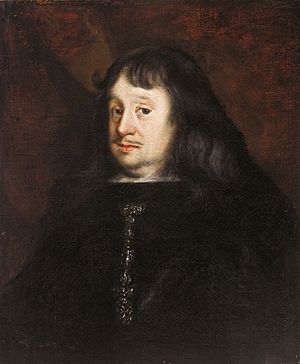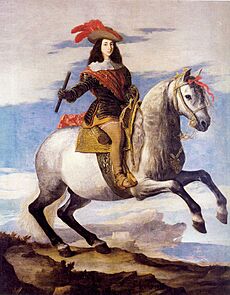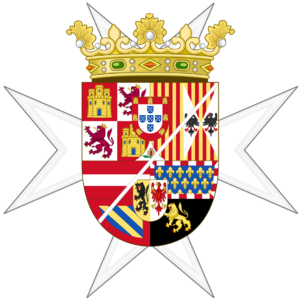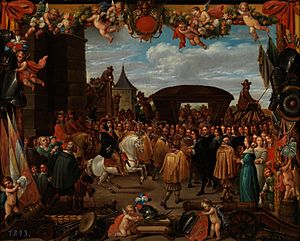John Joseph of Austria facts for kids
Quick facts for kids
John Joseph of Austria
|
|
|---|---|
 |
|
| Regent of Spain | |
| In office 1677 – 17 September 1679 |
|
| Monarch | Charles II |
| Governor-General of the Spanish Netherlands | |
| In office 1656–1659 |
|
| Preceded by | Leopold Wilhelm of Austria |
| Succeeded by | Luis de Benavides Carrillo, Marquis of Caracena |
| Personal details | |
| Born | 7 April 1629 Madrid |
| Died | 17 September 1679 (aged 50) Madrid |
| Parents | Philip IV of Spain María Calderón |
John Joseph of Austria (born April 7, 1629 – died September 17, 1679) was an important Spanish general and political leader. He was also known as John of Austria (the Younger). He was the only son of Philip IV of Spain born outside of marriage whom the King officially recognized. John was trained to be a military commander and to help run the government.
Don John worked hard for the Spanish Crown. He helped Spain in many places like Naples, Sicily, Catalonia, the Netherlands, and Portugal. From 1656 to 1659, he was the governor of the Spanish Netherlands. Even as the power of the Spanish Empire started to fade, John remained a popular hero.
Later, he had disagreements with his father's wife, Queen Mariana of Austria. This led to a palace coup in 1677. John sent Queen Mariana away and took control of the government for his half-brother, Charles II of Spain. Many people hoped he would save Spain, but his time in power was short. He died in 1679.
Contents
Early Life and Royal Recognition
John Joseph of Austria was born on April 7, 1629, in Madrid. His mother was María Calderón, a famous actress. Soon after John was born, his mother was sent to live in a convent.
John was raised in León by a woman who was not rich and probably didn't know who his real parents were. However, he received a very good education in Ocaña. In 1642, King Philip IV officially recognized John as his son. This was a big step for John. From then on, he began his career serving his father's interests, especially in the military.
Military Career and Achievements
John Joseph of Austria became a key military leader for Spain. He was sent to many places to help the Spanish Crown.
Putting Down Revolts in Italy
In 1647, Don John was sent to Naples. There was a big rebellion happening, first led by a man named Masaniello. John arrived with a navy and soldiers to support the Spanish viceroy. He ordered his forces to surround the city held by the rebels. He waited until the rebels were tired and their French leader, Henry II, Duke of Guise, made mistakes. Then, John moved in to crush the revolt and push out the French.

After Naples, he became the viceroy (a ruler acting for the king) of Sicily. In 1651, he was called back to Spain to help end a revolt in Catalonia. This region had been rebelling since 1640.
Ending the Catalan Revolt
On his way to Catalonia, John showed his skill by capturing a French warship called the Lion Couronné. The Catalans had asked the French for help in their revolt, but the French had been too bossy. This made many Catalans want to support the Spanish King again.
By the time Don John took command, most of Catalonia was already back under Spanish control. His main job was to oversee the final siege of Barcelona. In October 1652, the revolt officially ended. In both Naples and Catalonia, John acted as a peacemaker. His kind manner, charming personality, and good looks made him very popular with the people.
Campaigns in Flanders and Portugal
In 1656, Don John was sent to command troops in Flanders, which was rebelling against Spain. At the Battle of Valenciennes in 1656, he showed great bravery. He led a surprise cavalry charge that caught the French completely off guard.
However, in 1658, he took part in the Battle of the Dunes. This battle was against the French and British forces. Don John's army was defeated, and he failed to stop the siege of Dunkirk. He didn't listen to the good advice from Louis, Grand Condé, a famous general.
From 1661 to 1662, he fought against the Portuguese in Extremadura. The Spanish soldiers were not well-supplied or paid regularly. Even though they had more soldiers, their morale was low. In 1663, the Portuguese forces were strengthened by English troops. Don John's army was completely defeated at the Battle of Ameixial.
After this defeat, his father, King Philip IV, still trusted him. But Queen Mariana, the mother of the young Charles II of Spain, did not like Don John. She saw him as a threat. So, Don John was removed from command and sent to his estate.
Political Struggles and Leadership
After King Philip IV died in 1665, Don John became the main leader against the government run by Philip's widow, Queen Mariana. Queen Mariana and her advisor, Juan Everardo Nithard, even arrested and executed one of John's trusted servants.
In response, Don John led a rebellion in Aragon and Catalonia. This led to Nithard being sent away from court in February 1669. However, Don John only became the viceroy of Aragon, not the main leader of Spain.
In 1677, Queen Mariana made many people angry by favoring Fernando de Valenzuela. Don John was able to remove Queen Mariana from the court and became the chief minister of Spain. People had high hopes for his leadership. But his time in power was short and did not bring the changes people hoped for. Don John died on September 17, 1679.
Images for kids
See also
 In Spanish: Juan José de Austria para niños
In Spanish: Juan José de Austria para niños




